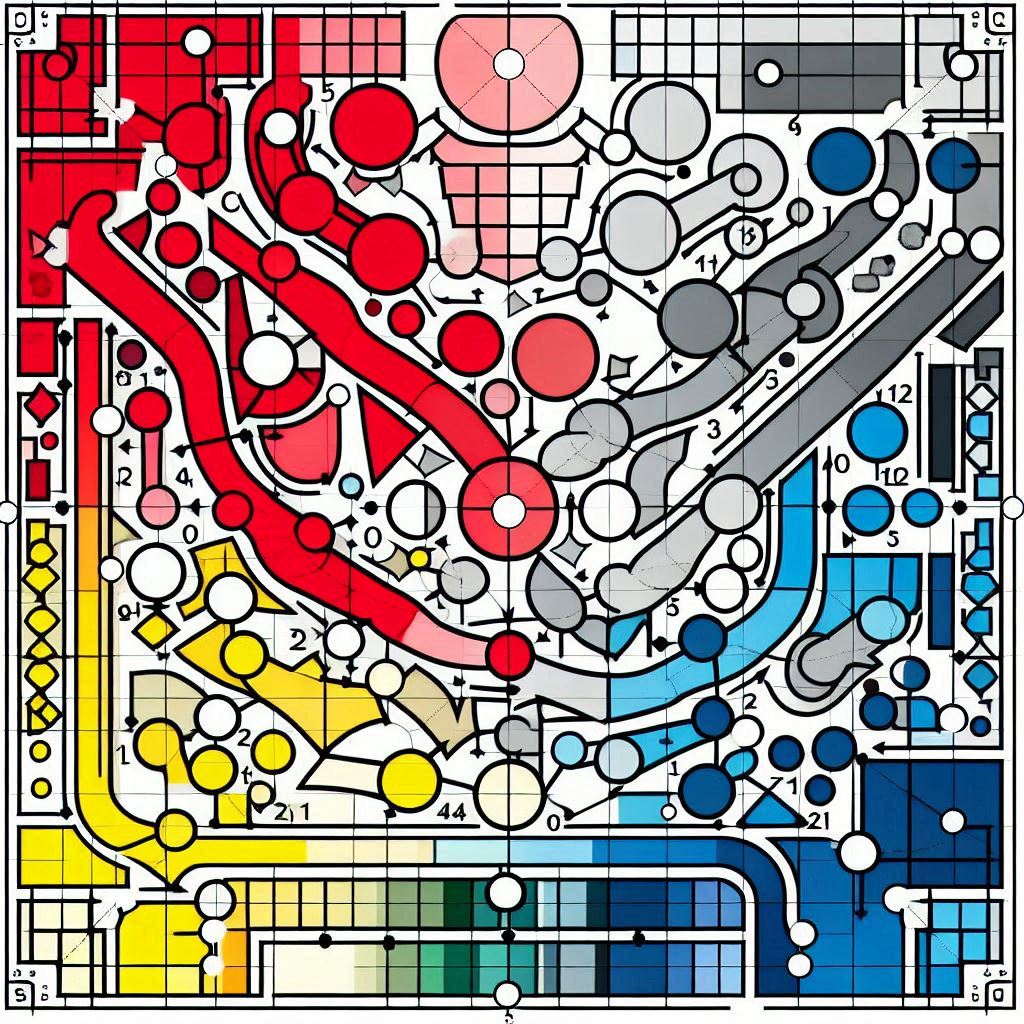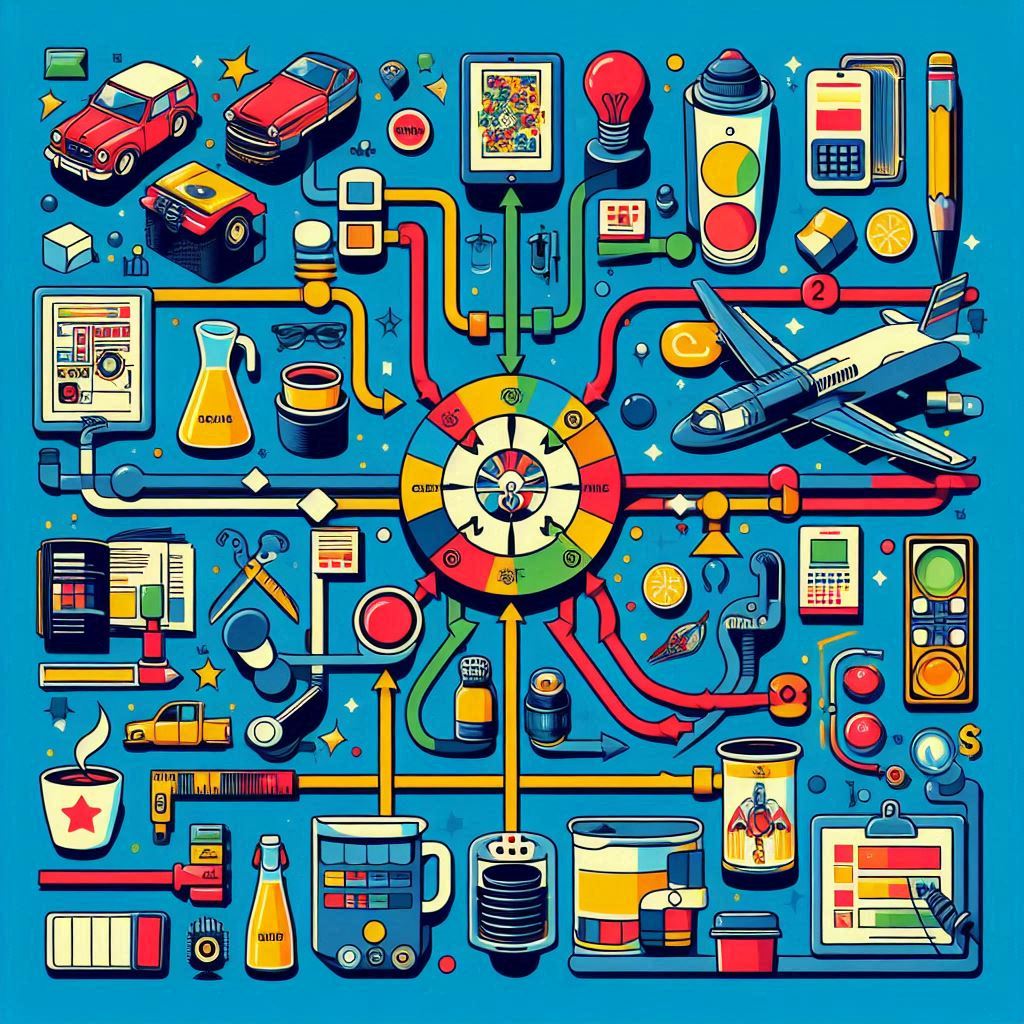Get Ahead: Use a Strategy Canvas for Cool Ideas!
Do you want to stand out and bring new ideas? The strategy canvas can help. It analyzes competition and finds growth opportunities. It helps develop creative ideas to get ahead. We’ll explore using it to generate new concepts and stay ahead.
What’s a Strategy Map?
A strategy map is a visual representation of an organization’s strategy. It shows where the organization is now and where it could go. This helps the organization understand and communicate its competitive strategy more clearly.
The map helps the organization achieve its goals by comparing its offerings to its competitors. This identifies unique value propositions and areas for differentiation. The map includes factors of competition, what buyers receive, and the organization’s and its competitors’ cost structures.
It also shows where the organization and its competitors invest, product and service competition, and the value customers get from competitive offerings.
Create Your Own Innovator’s Path with a Strategy Map

A strategy map can help organizations visualize their current strategy and plans. It captures the key elements of strategy, such as competition, buyer offerings, and cost structures.
Organizations can use a strategy map to understand where their investments are and what customers get from competitors. This helps find new market spaces and make innovative strategies.
Organizations can start by comparing their offerings to competitors to build a strategy map for innovation. Then, they can see what factors the industry competes on, understand competitor investments, and assess customer value.
By using a strategy map to understand products, services, and delivery in the industry, organizations can find ways to stand out and become market leaders. Southwest Airlines used the Strategy Canvas to make its strategy different and gain an edge in the airline industry.
Building Your Strategy Map: A Step-by-Step Guide
Step 1: Who’s Your Competition?
Knowing your industry or market’s main competitors is important. It helps you innovate with the strategy canvas for competitiveness. By identifying their strengths and weaknesses compared to your business, you can find opportunities for improvement.
For example, if they excel in pricing, but your business has superior customer service. This analysis lets you see how your business stands out. Then, you can adjust your strategy to highlight your unique value. This creates a strong blue ocean strategy, making the competition irrelevant. Southwest Airlines used this approach to set itself apart and gain an edge in the market.
Step 2: What Makes You Different?
A product or brand stands out because of its unique qualities or characteristics. It could be innovative features, exceptional quality, outstanding customer service, or a distinctive brand identity.
Furthermore, a brand differentiates itself from competitors through its approach or strategy. Factors such as pricing, distribution channels, marketing tactics, or a focus on sustainability play a role.
Companies can communicate and leverage their unique selling points through targeted advertising campaigns, partnerships with influencers, social media engagement, or participation in industry events and trade shows.
By leveraging these points, a brand can stand out in the marketplace and create a competitive edge.
Colors and Shapes You’ll See in a Strategy Map

A strategy map uses different colors and shapes to represent elements of a business strategy.
For example, bright colors like red and orange may show areas of high competition, while cool colors like blue and green could represent elements of differentiation and low competition. Shapes like circles or ovals can indicate areas of focus or investment, while sharp angles like triangles could represent potential areas of high risk.
Using specific colors and shapes in a strategy map helps communicate complex strategic concepts visually. It makes it easier for key stakeholders to understand and identify critical elements of the strategy quickly. With colors and shapes, a strategy map can effectively convey meaningful insights about the competitive landscape, value proposition, and cost structures of an organization in a visually engaging way.
Real-life Strategy Map Examples
How the Wine Brand [yellow tail] Stood Out
![]()
The wine brand [yellow tail] is different from other brands. It’s aimed at people who don’t know much about wine and want something easy to enjoy. Their marketing and branding are all about having fun and feeling relaxed, making them stand out in the wine industry. They use bright packaging and simple labels to show what flavors are in the wine. By doing this, they’ve made it easier for more people to like their wine.
They also keep the price affordable while keeping the quality consistent, which helped them become successful. In general, [yellow tail] succeeded by being more casual in an industry that’s usually very traditional.
How Southwest Airlines Flew Higher
Southwest Airlines differentiated itself in the competitive airline industry by implementing a strategy that focused on creating uncontested market space and making competition irrelevant. Specifically, the airline utilized Strategy Canvas to graphically capture its current strategic landscape and future prospects, allowing it to configure its offering to buyers concerning those of its competitors.
By doing so, Southwest Airlines was able to crisply communicate the factors of competition and the offering level buyers receive across these factors. This strategic approach allowed the airline to see where they and their competitors were investing and what customers received from existing competitive offerings.
As a result, Southwest Airlines identified areas of differentiation and innovation that allowed them to succeed in the industry.
Using Your Strategy Map for Making Cooler Products

Strategy maps help find areas to improve in product development. They help companies analyze and compare their current strategy to competitors’ to spot gaps and opportunities. By using the strategy canvas, companies can see where they and their competitors are investing, which helps to identify changes for improvement.
To create better products using a strategy map, companies should identify competitive factors and levels of offerings in comparison to their rivals. With the insights from the strategy canvas, they can develop unique value propositions, set themselves apart, and eliminate overvalued factors. This can reduce costs and lead to innovations that unexpectedly address customer needs.
The “Raise, Reduce, Create, Eliminate” framework can be applied to product development using a strategy map. Companies can decide which factors to raise, eliminate, create, or reduce compared to their competitors. This helps make strategic and differentiated product decisions.
The Four-move Plan to Be a Leader
Raise: What to Improve
The current strategy map can be improved by identifying areas where the organization’s offering is lacking compared to its competitors. By pinpointing these areas, the organization can enhance those factors to gain a competitive edge. This would help the organization better align its goals and objectives.
Addressing any weaknesses or limitations in the current strategy map, such as outdated factors of competition or cost structure inefficiencies, is also essential. It’s crucial to incorporate a clearer understanding of customer needs and preferences and consider the industry’s competitive landscape.
By doing so, the organization can ensure its offering is unique and attractive to buyers, contributing to its strategic success.
Reduce: What to Use Less
Reducing single-use plastics, energy, and water dramatically benefits the environment and individual well-being. By using less plastic, people can reduce pollution and protect marine life. Conserving energy not only cuts carbon emissions but also lowers utility bills. Similarly, water conservation helps preserve this valuable resource and reduces water bills. Simple strategies like using refillable water bottles, turning off lights, and fixing leaky faucets can make a big difference.
These practices support a more sustainable environment and save money in the long run.
Create: What to Start Doing
It’s important to start by identifying the key factors of competition in the industry. This includes the offerings buyers receive across these factors and the strategic profiles and cost structures of the organization and its competitors.
This information can visually represent the organization’s current strategic landscape and prospects. This is called a strategy canvas. Once this is developed, companies can start investing in product, service, and delivery factors that set them apart from competitors.
By using the insights gained from the strategy canvas, organizations can identify new market opportunities and uncover areas for innovation. To create and implement a strategy map, businesses should involve all levels of the organization to ensure alignment and shared understanding.
Additionally, leaders must visualize and communicate their strategies clearly and concisely. This ensures that all organization members can understand and implement the plan effectively.
Eliminate: What to Stop Doing
The strategy canvas allows organizations to analyze, identify, and prioritize elements that need to be eliminated to achieve better market results. In doing so, they can assess competition factors, offering levels received by buyers, and their and competitors’ strategic profiles and cost structures. By utilizing these visual analytics, companies can identify ineffective processes, products, or services and stop investing in them to make room for innovations.
This prioritization aligns with the Blue Ocean Strategy of creating uncontested market space and making competition irrelevant.
Additionally, by understanding where they and their competitors are investing, organizations can effectively identify what elements of their current strategy must be eliminated to create new strategic initiatives. Southwest Airlines, for example, successfully differentiated its strategy using the insights gained from the strategy canvas, allowing the airline to stand out in a highly competitive industry.

Vizologi is a revolutionary AI-generated business strategy tool that offers its users access to advanced features to create and refine start-up ideas quickly.
It generates limitless business ideas, gains insights on markets and competitors, and automates business plan creation.


